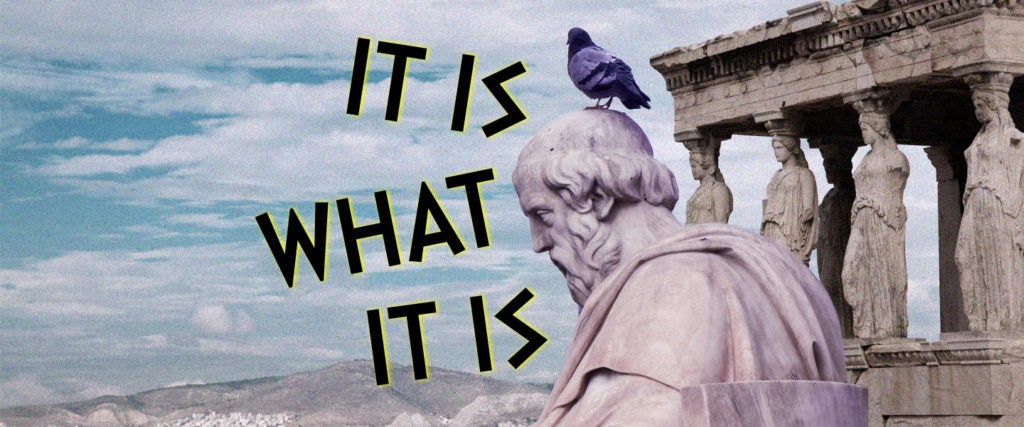In 1949, J.E. Lawrence published a column in The Nebraska State Journal about the rugged frontier life. It included a phrase that would become a pet peeve for any number of English-speakers. “New land is harsh, and vigorous, and sturdy,” he wrote. “It scorns evidence of weakness. There is nothing of sham or hypocrisy in it. It is what it is, without apology.”
It is what it is — a poetic description of the stark realities we see in nature. By the early 21st century, however, “it is what it is” was something of a verbal crutch for people acknowledging undesired outcomes. William Safire picked the cliché apart in a 2006 “On Language” column for the New York Times Magazine, noting its common usage in sports-related press conferences. (Tough loss on the field? It is what it is.) Safire described the reflexive comment as “a deliberate tautology,” or, in his term, “tautophrase.” Usually “accompanied by a shrug, it is used to deflect inquiry with panache,” he wrote.
Fourteen years later, Trump tried just that, saying “it is what it is” to Axios reporter Jonathan Swan when asked about mounting coronavirus deaths in the U.S.
Trump on 1,000 Americans a day dying from COVID-19: "It is what it is" https://t.co/kLWntKaZ3V
— CBS News (@CBSNews) August 5, 2020
"It is what it is," says Pres. Trump on the US' staggering death toll.
"It would be a cruel and heartless thing to say if it came from any individual, but it didn't," says @andersoncooper. "It came from the most powerful officeholder in the world, the President." pic.twitter.com/4cN302pC5Z
— CNN (@CNN) August 5, 2020
President Trump on "it is what it is" quote: "The message that I have is very simple: nobody can do what I've done." pic.twitter.com/qdxdSNm3Wm
— The Hill (@thehill) August 6, 2020
One obvious interpretation of Trump’s comment: He doesn’t care. The ravages of the pandemic are nothing but brightly colored bar graphs to him. Yet the umbrage we’ve taken at that familiar sequence of words — spoken about a deadly crisis by the man who bears the greatest responsibility for it — provides a chance to dig deeper into the exact meaning of “it is what it is.”
“I like to talk about ‘it is what it is’ in my logic classes as an example of a tautology that is nevertheless sometimes still informative,” Garrett Pendergraft, an associate professor of philosophy at Pepperdine University’s Seaver College, tells me in a Twitter DM. “If you try to interpret it at the surface level, then it doesn’t actually tell you anything — like ‘it’s raining or it’s not raining.’ But oftentimes when it’s used, it’s expressing something else, like: ‘There’s nothing I can do about it now.’ (This seems to happen a lot in post-game press conferences.)”
Certainly Trump can be counted on to insist that anything bad that happens under his administration is just a fact of life, nothing to do with him. Yet that’s not all “it is what it is” communicates. Whenever someone utters this, Pendergraft says, “the charitable thing to do is assume that they mean something else. Usually context helps us figure out what that other thing is. […] It seems like a pretty callous thing to say in a conversation about COVID.” He sees a link to the semi-prophetic remark “Whatever will be, will be,” which he calls “sort of a preemptive way of saying ‘it is what it is.’” Indeed, Trump’s attitude since early this year has always seemed to be that everything will work out fine, and if not, well, maybe that’s just what fate has in store.
“This seems to me more a philosophy of language issue than a metaphysics issue,” says Helen De Cruz, a philosophy professor and Danforth Chair in the Humanities at Saint Louis University. She points out that the phrase is hardly associated with good news: “We never say, ‘I won the lottery. It is what it is.’ Or ‘The Berlin Wall fell. It is what it is.’ What is the conversational context in which we say this? What are we aiming for if we say this?” she asks.
She refers to a seminal work by the philosopher of language J.L. Austin, How to Do Things With Words. For Austin, speech is an act with effects; if you verbally christen a ship, for example, “the act of saying does something.” Really, she continues, “you are doing three things” when you say “it is what it is.”
The first pertains to locution. “The literal meaning,” De Cruz says. “Now clearly, this is a tautology. Things are what they are. If that’s all [the phrase] did it would be meaningless. But you also have [the second factor], illocution — intention of the speaker. Finally, there is perlocution, ‘how is the speech act received by listener.’” (As you can see above, Anderson Cooper and other journalists who heard Trump’s interview were appalled by his “it is what it is,” reading it as a heartless dismissal of suffering and dying Americans.)
“Now I think what Trump wants to convey to us is a sense of inevitability,” De Cruz observes. “‘It is what it is’ calls to mind something that is unchangeable. Note, in other speech acts, he says the virus will go away, so he’s rather inconsistent.” There she touches on what’s so weird about Trump falling back on the trope: it’s in some way an affirmation of reality, which elsewhere he takes great pains to avoid.
Still, De Cruz says, it’s in keeping with his character as a “classic bullshitter […] in the sense of Harry Frankfurt,” a philosopher of Princeton University who wrote the popular 1986 paper, later released as a book, On Bullshit. Frankfurt’s argument is that “bullshit” can be distinguished from lies because it has no regard for truth one way or the other. “In classic philosophy of language you have several kinds of what is called uncollaborative speech acts,” De Cruz says, including “the baldfaced lie, the white lie, bullshit.” The latter “is just basically a kind of bluffing. You just say whatever it takes to make your audience do what you want them to do. Mostly that will be lies, but sometimes truth, sometimes also just meaningless statements.” The Trumpian mode.
Seen that way, Trump’s “it is what it is” barely rises to the level of tautology, if that — it’s euphemistic filler intended to negate the horror of our non-response to viral contagion. He says “it is what it is” without quite listening to Swan, nor totally grasping the dreadful “it” he’s talking about, because all he wants is to move along. As a citizen of this country, what can you even say?
It is what it is.

